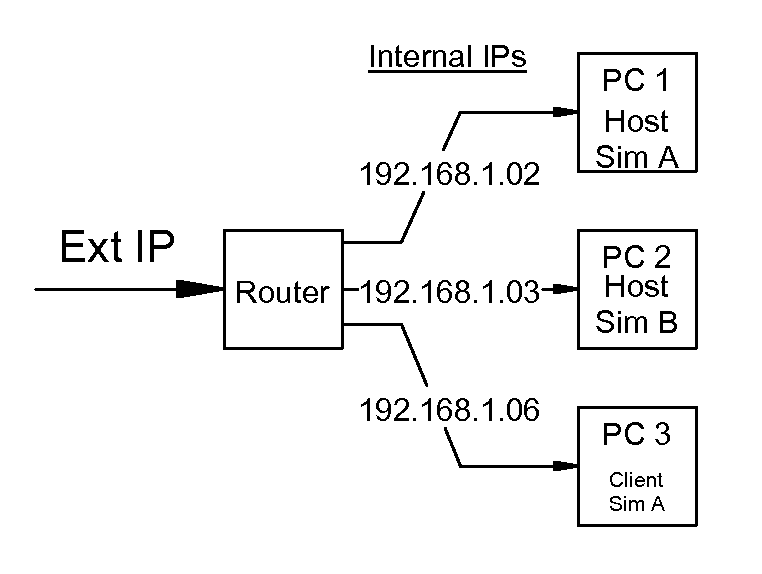Port Forwarding
To host a multiplay session, you must set up your own system first so that others can connect to your master version of the sim. If you are using a router (the method for most domestic systems connected to the internet) you must set up port forwarding correctly, otherwise other people will not be able to connect to your session. These notes explain the basic theory behind what you need to do and point to some useful tools for setting up that port forwarding.
To use a simple analogy, let's assume you want to ring Jones & Co to talk to Mr. Smith. You would look up the telephone number and dial it to connect to the switchboard at Jones & Co. In the same way that Jones & Co has a unique telephone number, when your computer is on-line it has a unique ID which is your external IP. However, it is not like a permanent telephone number as your ISP will probably change the number allocated to you on a regular basis. You can find your current external IP using the "What's my Internet Address" button on the last page of the Loader screen. Your internal IP is displayed in the adjacent box marked "Your IP address is". Why you need your internal IP is explained below.
Just as an office will have a switchboard and extensions, so does your router. Every computer connected to your router has its own "extension number" or internal IP. These are typically of the form 192.168.xxx.xxx although routers vary in what they allocate. There may be fewer than three digits in any of the four blocks. These addresses may be dynamic in the sense that each time you power up, the router may pick up the computers which are on line one by one and allocate them the next number or they may be fixed (the router uses the same IP each time it connects to the same computer). It doesn't make any difference provided you know what the internal IP of your SimSig computer is when you want to run a session. Finally there is the port number (usually 50505 or 50507 for SimSig). To go back to the telephone analogy, when someone rings Jones & Co and asks for Mr. Smith, the operator finds the extension number for Mr. Smith and connects the call. When a SimSig player connects to your external IP, their computer then does the equivalent of asking for Mr. Smith by saying "I want to connect to Port 50505, please". Your router then needs to look at the instructions you have given it to see which internal IP should receive that message (like the telephonist looking up Mr. Smith's extension number and connecting the call).
So you need to make sure you have it clearly in your own mind before you start about when you need to use the external IP and when you need to use the internal IP. Then you need to instruct your router to forward traffic for whichever port to the internal IP. You don't need to use the external IP at all when you are setting up the forwarding on your router but you do need to pass it on to those wishing to connect to your computer.
So in summary, there are three things you need to do when you want to host a multiplay session:
1) you need to set up port forwarding using your internal IP
2) you need to advise those wishing to join of your external IP
3) you need to advise those wishing to join you of the port number to use.
Example
It is possible to host more than one sim on the same external IP using different ports for each sim. Schematically, this would look like:

In the example above we have PC1 hosting simulation 'A' on port 50505 and PC2 hosting simulation 'B' on port 50507.
The router needs to be set up to forward port 50505 to Int IP 192.168.1.02, and port 50507 to Int IP 192.168.1.03. Then any incoming 'call' for port 50505 will be directed via 192.168.1.02 to PC1 and Sim A, and 50507 to PC2 and Sim B.
Note that PC1 could act as Host/server for both sims by routing port 50507 to it as well as 50505.
If the sims need to be chained, Sim B can connect by either using IP 192.168.1.02:port 50505 (internally) or Ext IP:port 50505.
Similarly PC3 can connect (as a client) to Sim A on PC1 by 192.168.1.02:50505 (internally) or Ext IP:50505. The office switchboard analogy is Mr Brown on PC3 could just dial the internal extension, or use an outside line to dial back into his own office and ask for Mr Smith's extension.
Notes
- You can find the internal IP for a PC if you start a simulation in Network/Server mode, and the ext IP by using the relevant button.
- http://portforward.com/ is a useful site for configuring specific routers. The site tries to direct you to a link to buy their automatic set-up software (PFConfig) at a number of stages in the process. However, if you keep searching on each page there is always a link somewhere to the next stage in setting up your router manually, avoiding the need to make an unnecessary purchase.
- There is a simple Port Forwarding tool available here and the first 6 or 7 minutes of this video gives an idiots guide on how to use.
Last edited by postal on 23/12/2018 at 14:25